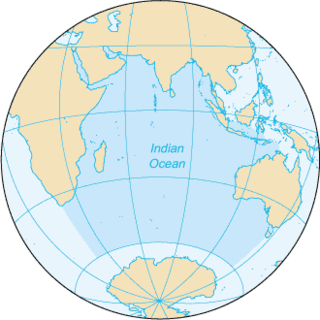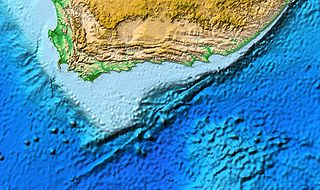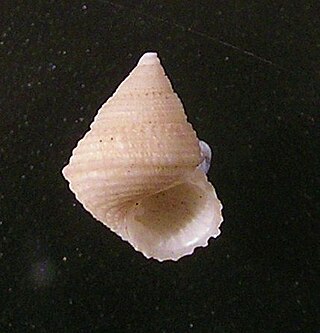
The Indian Ocean is the third-largest of the world's five oceanic divisions, covering 70,560,000 km2 (27,240,000 sq mi) or approx. 20% of the water on Earth's surface. It is bounded by Asia to the north, Africa to the west and Australia to the east. To the south it is bounded by the Southern Ocean, or Antarctica, depending on the definition in use. Along its core, the Indian Ocean has large marginal, or regional seas, such as the Andaman Sea, the Arabian Sea, the Bay of Bengal, and the Laccadive Sea.

Humpback dolphins are members of the genus Sousa. These dolphins are characterized by the conspicuous humps and elongated dorsal fins found on the backs of adults of the species. They are found close to shore along the coast of West Africa and right along the coast of the Indian Ocean from South Africa to Australia. Several institutions have made a proposal to divide the Indo-Pacific species into two distinct species: the Indo-Pacific humpback dolphin and the Australian humpback dolphin.

The Agulhas Bank is a broad, shallow part of the southern African continental shelf which extends up to 250 km (160 mi) south of Cape Agulhas before falling steeply to the abyssal plain.

Clypeostoma cecileae is a species of sea snail, a marine gastropod mollusc in the family Chilodontaidae.

Perrinia is a genus of sea snails, marine gastropod mollusks in the family Chilodontaidae.

Perrinia stellata is a species of sea snail, a marine gastropod mollusc in the family Chilodontaidae.

Turcica is a genus of sea snails, marine gastropod mollusks in the family Eucyclidae.

Clypeostoma is a genus of mostly small deep water sea snails, marine gastropod mollusks in the family Chilodontaidae.

Pholidotrope is a genus of mostly small deep water sea snails, marine gastropod molluscs in the family Chilodontaidae.

Ascetostoma providentiae is a species of sea snail, a marine gastropod mollusc in the family Chilodontaidae.
Herpetopoma helix is a species of sea snail, a marine gastropod mollusc in the family Chilodontaidae.

Perrinia angulifera is a species of sea snail, a marine gastropod mollusc in the family Chilodontaidae.

Perrinia concinna is a species of sea snail, a marine gastropod mollusc in the family Chilodontaidae.

Perrinia squamicarinata is a species of sea snail, a marine gastropod mollusc in the family Chilodontaidae.
Vaceuchelus gemmula is a species of sea snail, a marine gastropod mollusk in the family Chilodontidae.

The Marine biodiversity of South Africa is the variety of living organisms that live in the seas off the coast of South Africa. It includes genetic, species and ecosystems biodiversity in a range of habitats spread over a range of ecologically varied regions, influenced by the geomorphology of the seabed and circulation of major and local water masses, which distribute both living organisms and nutrients in complex and time-variable patterns.
The East African coral coast is a marine ecoregion along the eastern coast of Africa. It extends along the coasts of Kenya, Tanzania, and northern Mozambique, from Lamu in Kenya to Angoche in Mozambique. It adjoins the Northern Monsoon Current Coast ecoregion to the north, and the Bight of Sofala/Swamp Coast ecoregion to the south.
The Biodiversity of South Africa is the variety of living organisms within the boundaries of South Africa and its exclusive economic zone. South Africa is a region of high biodiversity in the terrestrial and marine realms. The country is ranked sixth out of the world's seventeen megadiverse countries, and is rated among the top 10 for plant species diversity and third for marine endemism.












